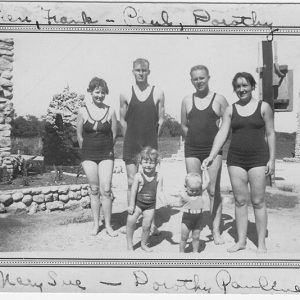Archaeology Update for the Week of January 16
It’s the middle of January already?!? Well, yeah… I guess it would be. It’s been a week since the last time we checked in. I hope everyone is having a good first half of the month and is looking forward to a great second half! If anyone out there attended the Annual Meeting of the Society for Historical Archaeology in Saint Charles, MO, just outside of Saint Louis, last week, we hope it went well! Conferences like those are great places for archaeologists to get together and learn from one another and be inspired to try new things. If you’re an archaeologist or you want to be one when you grow up, plan to attend a lot of conferences!
Enough of that… Let’s get to the good stuff!
We’re Movin’ Right Along in Block A
With a good shelter set up and decent weather, crews have been digging away in Block A. Hey! That’d make a great chant! “Digging away in Block A! Digging away in Block A!” While that chant takes the country by storm, the Block A crew will be down to about 1.5 meters across 20 test units. That’s about 30 cubic meters of soil removed. That’s more than 100,000 pounds of dirt, or the weight of an M1 Abrams tank.
Digging below the large midden feature (Feature 55) is almost completely removed within Block A and the units have exposed another, older feature below it. This was our Featured Feature in last week’s live video broadcast. The crews plan to remove that feature this week and we hope to be able to show you how it went in a future update. Also in Block A, Mindy found a pretty good-sized portion of a deer mandible! That’s the name for the bone that makes up the lower half of the mouth; the part that opens and closes when you talk to your friends. That fragment was mapped in place using the surveying instrument we use called the Total Station, then it was removed and will be analyzed with all of the other bone artifacts that have been recovered.

The crew “Digging Away in Block A!” You can see the remnants of the large burned rock midden, Feature 55, toward the background in the higher unit levels and the larger feature just below it that we’ll be studying closely this week.
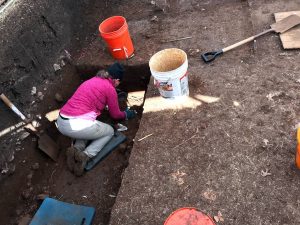
Here’s a photo of Mindy carefully clearing back the soil covering the deer mandible (right next to Mindy’s hand).

Here’s a time-lapse of the Block A crew excavating Feature 55 and preparing to map, or as we call it “Shoot In” the deer mandible using the Total Station before it was removed.
Block C must’ve been a big fan of The Secret
Back in the mid-2000s, this book called The Secret swept the country. Its author, Rhonda Byrne, argued that if you just think about something you want hard enough, be it money or fame or whatever, it will come to you. It was quite the sensation, particularly after Oprah featured it on her show. I didn’t catch the program, nor did I read the book, but I’m pretty sure that Block C was quite the fan and that it has been thinking long and hard that it desperately wants to be a swimming pool…

We should have known this was what Block C was thinking about during our earlier tour with the Texas Historical Commission and the US Army Corps of Engineers.
Block C is always the first to be inaccessible because it’s too wet and it’s also the last one we can get back into because it’s too muddy. You’ve seen many of our earlier posts and video updates where we’ve either said, “We are out of Block C this week to let it dry out,” or “We’re finally able to get back into Block C!” Just yesterday, the day the block was going to be dry enough to get back into, a water main right next to the block broke and flooded – yep – Block C! … Again… Ugh… It’s a shame, too, because Block C appears to contain some features and artifact assemblages that are distinct from elsewhere on the site. That means we have the potential to explore a different avenue of cultural occupation within it. One day! Just not today…
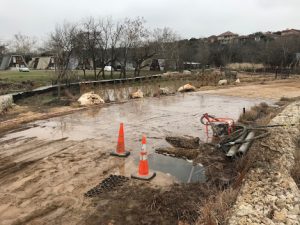
You can see the site of the water line leak next to the orange cones. Block C is just to the right of the rocks, just out of frame to the right.
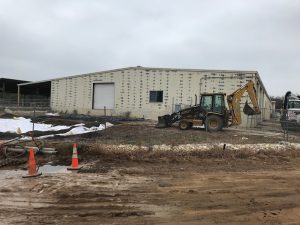
It isn’t good when a backhoe has to come out… But the repair was necessary and the workers were able to stay within the old trench that was dug to install the line, so the site wasn’t impacted. Whew!
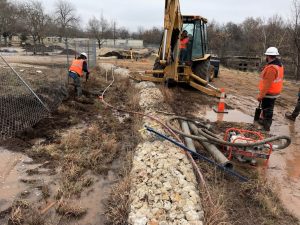
The line leak was repaired eventually…
We’ve reached a pause point in Block D
The excavation crew has been working quickly by the wellyard this past week.
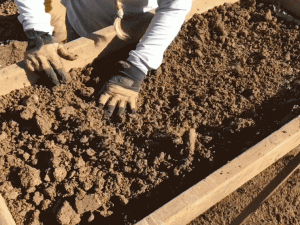
AmaTerra archaeologist Noel Steinle has been screening away over in Block D!
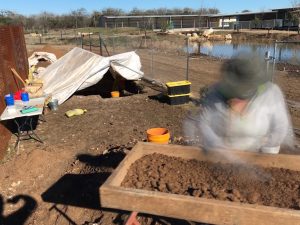
Look how quickly she’s working! She’s a blur!
They’ve reached a depth where they need to stop temporarily in order to get some shoring in place to assure the excavators are safe digging deeper. The story from last week continued within the block with relatively little to report. No significant features or large numbers of artifacts recovered. This might mean there was a sustained period with no one living in this particular spot or potentially a particularly heavy flooding event that dumped a lot of sediment in this location. The geoarchaeologist/geomorphologist who has been visiting the site periodically will give us better answers on that!
Now we just need to figure out what to do with all of this dirt. Dirt management is – possibly surprisingly – something archaeologists do need to consider when they conduct excavations. Digging produces a LOT of dirt and when it’s screened, it’s actually looser and less compact than when it’s in the ground. That means the dirt that’s dug up takes up more volume once it’s out of the block. All of that dirt has to go somewhere. With so many fences and roads in the way, Block D is a bit more problematic for dirt management, but maybe we can enlist the help of some of the heavier equipment that works around here every so often to move this giant pile somewhere else for a while. That’d sure be helpful.
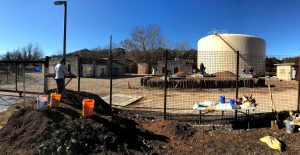
Noel has been slowly climbing upwards as the screened soil from Block D is brought out. We’re probably reaching the top of this mountain.
We had a great week of outreach last week
Last week was a busy one for us as we worked with the Headwaters team and members of the community to maximize the excavation’s benefit for the community both right now and into the future. Members of the Headwaters at the Comal Archaeology Committee, formed through this project to think about and plan ways for teachers to harness the excavations for current and future lesson planning, and for the larger community to learn from this site long after the excavations have finished, visited the site on Thursday and got a nice tour.
On Saturday, AmaTerra architectural historian Kurt Korfmacher led a tour of the site, the third in our three-part detailed tours and talks series. We had what I’d call a full house! This tour focused on the more recent history of occupations at the site and the New Braunfels Water Works in particular. Attendees got to see the excavations and walk around some of the Depression-era buildings within the wellyard that formed the first municipal water supply infrastructure for the City of New Braunfels. Thanks, Kurt!

Members of the Archaeology Committee talk with archaeologist Josh Hill about the progress and initial interpretations within Block D near the wellyard.

Kurt Korfmacher (blue shirt) talks to tour attendees about the water pressurization building, which dates to 1934, standing in roughly the same spot as the caretaker’s family photo from shortly after its construction (below).
